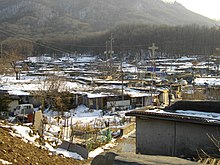Squatting in South Korea

Squatting in South Korea is the occupation of land or buildings without the permission of the relevant authorities. From the 1950s onwards,
shanty towns called P'anjach'on formed around cities, in particular the capital Seoul. As well as providing housing, squatting is used as a tactic by groups opposing gentrification
and striking workers.
History
At the end of the
Cheonggye River.[2] The state forcibly moved 15,000 squatters to a planned city which would later become Seongnam, but when richer inhabitants of Seoul started moving there as well, the squatters could not afford to live there and instead returned to Seoul. Squatters organised in their local area associations, for example in Mok-dong and Sanggye-dong.[2][3] Between 1985 and 1988, 720,000 squatters were evicted.[4]

Guryong Village (Nine Dragons village) in Gangnam District was squatted in 1988 after people were evicted from shanty towns as part of the preparations for the 1988 Summer Olympics. In 2012, 2,000 people lived there with little infrastructure. By 2020, the plans to redevelop the site had stalled and 1,000 people were still living there.[5]
By 2000, there was no accurate data on the number of squatters in South Korea.SsangYong Motor factory in Pyeongtaek was occupied for 77 days by over 1,000 workers in an industrial dispute.[7]
References
- ^ ISSN 0956-2478.
- ^ S2CID 154219426.
- ISBN 0-88936-861-9.
- S2CID 154687254.
- ^ Lee, Jeong Ho (17 December 2020). "The Slum Next Door to Gangnam Exposes South Korea's Wealth Gap". Bloomberg News. Retrieved 8 March 2021.
- ^ "At Least 4 Dead After Police Clash With Squatters in South Korea". Associated Press. March 25, 2015. Retrieved 8 March 2021.
- ^ .
